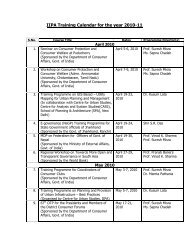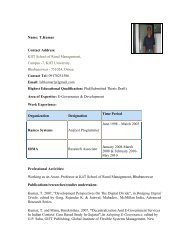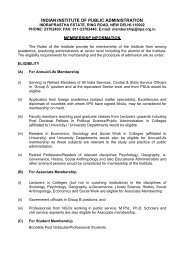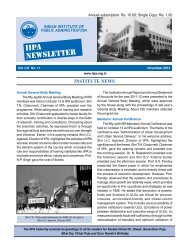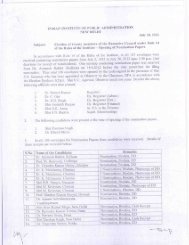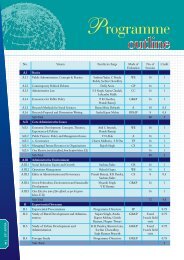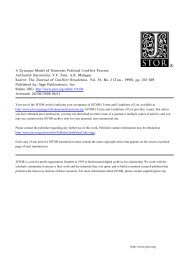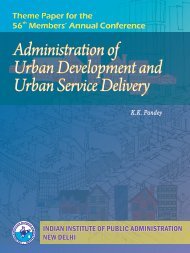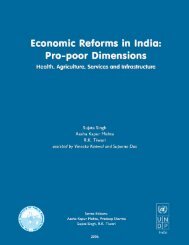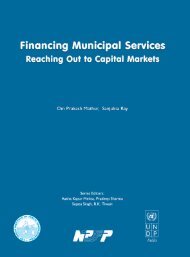Subcontracting and Economic - Indian Institute of Public Administration
Subcontracting and Economic - Indian Institute of Public Administration
Subcontracting and Economic - Indian Institute of Public Administration
Create successful ePaper yourself
Turn your PDF publications into a flip-book with our unique Google optimized e-Paper software.
<strong>Subcontracting</strong> And <strong>Economic</strong> Reforms In India With Special Reference To Agro-based Industries In India<br />
by the contracting firms. For this reason the monopolist<br />
faces a sales constraint in the second period. The size <strong>of</strong><br />
the second period dem<strong>and</strong> must be equal to the size <strong>of</strong><br />
the first period dem<strong>and</strong> as in this case, the size <strong>of</strong> dem<strong>and</strong><br />
is equal to the number <strong>of</strong> agents employed. Thus, while<br />
determining the product’s price, the monopolist faces the<br />
additional constraint that the size <strong>of</strong> dem<strong>and</strong> in both periods<br />
must be equal.<br />
After solving the pr<strong>of</strong>it maximisation <strong>of</strong> the monopolist<br />
subject to IR <strong>and</strong> IC constraints, the maximum pr<strong>of</strong>it <strong>of</strong><br />
the monopolist is given as,<br />
- 6<br />
In this case incentive compatibility constraint is not binding.<br />
In this two-period framework, due to imperfect information,<br />
the monopolist will employ the same set <strong>of</strong><br />
agents in both periods. So, to induce them to produce a<br />
high quality product for both periods, the monopolist<br />
has to <strong>of</strong>fer an excessively high value <strong>of</strong> r 2,<br />
which is more<br />
than enough to induce agent firms to produce a high<br />
quality product. So we have,<br />
________________7<br />
Given this restriction on r 2<br />
any combinations <strong>of</strong> (r 1<br />
, r 2<br />
) can<br />
be chosen by the monopolist, which will satisfy reservation<br />
constraint as equality. Due to imperfect information,<br />
with a large number <strong>of</strong> agents, the monopolist is facing a<br />
sales constraint in the second period <strong>and</strong> that is leading to<br />
excessive payment in the second period.<br />
However, the monopoly large firm will sign a contract<br />
with the promise <strong>of</strong> such a high payment in the second<br />
period, provided it is the best option for him too. As<br />
shown above, the stylised scheme discussed above leaves<br />
no other option for the monopolist. Hence, we conclude<br />
that when the monopolist’s future pr<strong>of</strong>it depends on the<br />
level <strong>of</strong> quality served in the initial period, the monopolist<br />
will find an incentive scheme for which an agent will actually<br />
supply the high quality product. The major implication<br />
is that the second period’s price per unit <strong>of</strong> product<br />
supplied by the agent should be announced higher than<br />
the minimum required to induce the agents to supply the<br />
high quality product.<br />
16




